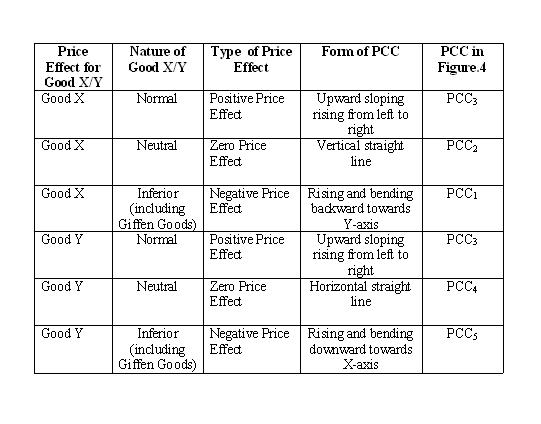PRICE EFFECT/Next
| Positive Price Effect |
The positive price effect measures changes in consumer's optimal consumption combination caused by changes in the price of one good, say price of good X (PX), which is a normal good. Price of another good, say good Y (PY) and consumer's income remaining unchanged.
Assumptions:
1. Consumer's preference for combinations of goods X and Y is given as represented by the indifference map.
2. Goods X and Y are normal goods.
3. Consumer's income and price of good Y (Py) are given and constant.
4. Initial price of good X (Px) is given.
Figure.1 starts with the initial optimal consumption combination attained at point e as discussed in CONSUMER'S EQUILIBRIUM. At combination e the consumer is having OX units of good X and OY units of good Y.
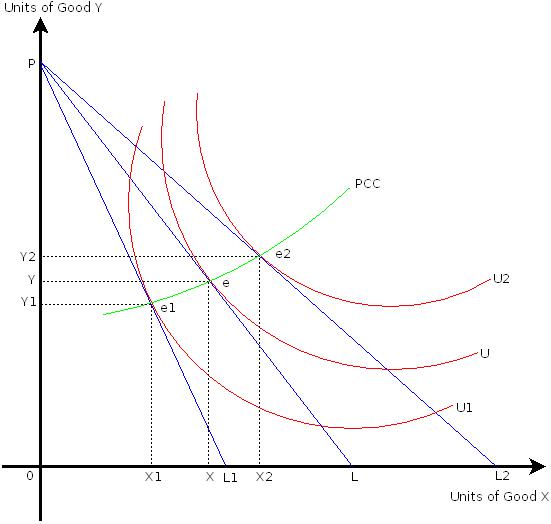
Whenever price of a good representing X-axis changes, the lower point of the budget constraint shifts as shown in Figure.1. When the price of good X increases, the budget constraint then becomes steeper, as the lower end point moves leftwards. This is shown by budget constraint PL1. The optimal consumption is located at point e1 at which the consumer buys OX1 units of good X and OY1 units of good Y. Consumer’s total utility decreases as the optimal consumption combination is located on a lower indifference curve U1.
Similarly, when the price of good X decreases, the budget constraint becomes flatter, as the lower end point moves rightwards. This is shown by budget constraint PL2. The optimal consumption is now located at point e2, at which the consumer buys OX2 units of good X and OY2 units of good Y. Consumer’s total utility increases as the optimal consumption combination is now located on a higher indifference curve U2.
Figure.1 shows a positive price effect as with increase in the price of good X (Px), the consumer tends to buy lesser units of good X. Similarly, with decrease in the price of good X, the consumer tends to buy more units of good X.
The curve obtained by joining optimal consumption combinations such as e1, e and e2 is called the price consumption curve (PCC). The PCC is a locus of a point that passes through optimal consumption combinations attained at alternative prices of good X. The PCC in Figure.1 is rising upwards to the right. It shows that the consumer successively moves on a higher indifference curve and becomes better off, with a fall in the price of good X (PX).Chart.2 presents a summary of Figure.1.
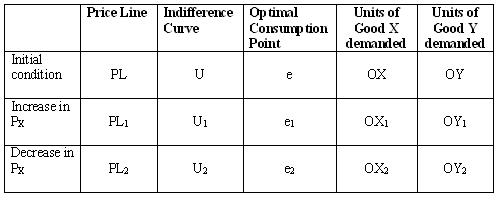
| Negative Price Effect |
The negative price effect measures changes in consumer's optimal consumption combination caused by changes in the price of one good, say price of good X (PX), which is an inferior good (including Giffen goods). Price of another good, say good Y (PY) and consumer's income remaining unchanged.
Assumptions:
1. Consumer's preference for combinations of goods X and Y is given as represented by the indifference map.
2. Goods X is an inferior (including Giffen Goods) good and good Y is a normal good.
3. Consumer's income and price of good Y (Py) are given and constant.
4. Initial price of good X (Px) is given.
Figure.2 starts with the initial optimal consumption combination attained at point e at which the consumer is having OX units of good X and OY units of good Y.
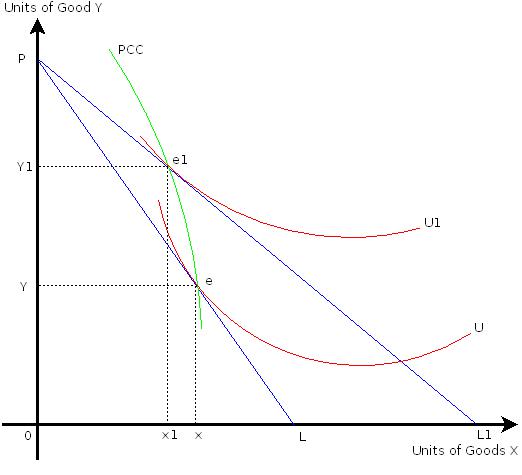
When the price of good X decreases, the budget constraint becomes flatter, as the lower end point moves rightward. This is shown by budget constraint PL1. The optimal consumption is now located at point e1, at which the consumer now buys OX1 units of good X and OY1 units of good Y.
Understand that consumer’s total utility has increased as the optimal consumption point is now located on a higher indifference curve U1. The consumer is better-off in terms of total utility. However, she/he reduces consumption of good X from OX to OX1 units as good X is inferior. As mentioned in chart.1, we observe direct relationship between price and quantity demanded of good X.
Figure.2 shows a negative price effect, as the consumer tends to buy lesser units of good X with decrease in the price of good X (Px). The PCC obtained by joining optimal consumption combinations such as e, and e1, in Figure.2 rises upwards but bending backwards. It shows that the consumer successively moves on a higher indifference curve and becomes better off, with a fall in the price of good X (PX). Simultaneous, She/he is also reducing purchase of good X as it is an inferior good. Chart.3 presents a summary of Figure.2.

| Zero Price Effect |
The zero price effect measures changes in consumer's optimal consumption combination caused by changes in the price of one good, say price of good X (PX), which is a neutral good. Price of another good, say good Y (PY) and consumer's income remaining unchanged.
Assumptions:
1. Consumer's preference for combinations of goods X and Y is given as represented by the indifference map.
2. Good X is a neutral good and good Y is a normal goods.
3. Consumer's income and price of good Y (Py) are given and constant.
4. Initial price of good X (Px) is given.
Figure.3 starts with the initial optimal consumption combination attained at point e at which the consumer is having OX units of good X are purchased and OY units of good Y.
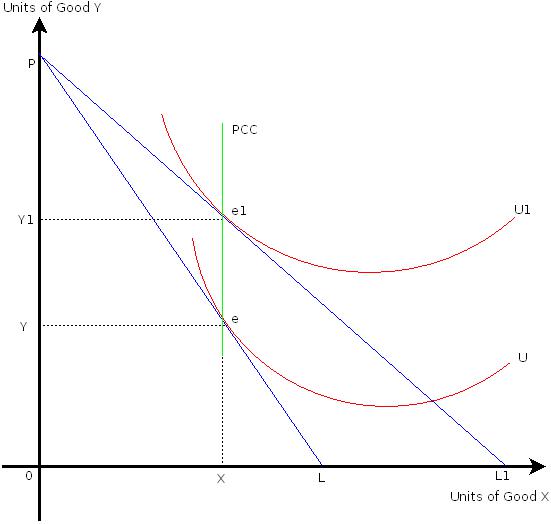
When the price of good X decreases, the budget constraint becomes flatter, as the lower end point moves rightward. This is shown by budget constraint PL1. The optimal consumption is located at point e1, at which the consumer now buys same OX units of good X and OY1 units of good Y.
Understand that consumer’s total utility has increased as the optimal consumption point is now located on a higher indifference curve U1. The consumer is better-off in terms of total utility. However, she/he keeps consumption of good X to same OX units as good X is a neutral good. As mentioned in chart.1 we observe no change in quantity demanded of good X.
The pcc obtained by joining optimal consumption combinations such as e, and e1, in Figure.3 is a vertical straight line. It shows that the consumer successively moves on a higher indifference curve and becomes better off, with a fall in the price of good X (PX). However, she/he is keeping purchase of good X fixed as it is a neutral good.
Chart.4 presents a summary of Figure.3.

| Forms of Price Consumption Curve |
In the above discussion on positive, negative and zero price effects we have considered good X to be normal good, inferior good and neutral good respectively. Similarly, we can explain price effect for different types of good Y. Figure.4 shows different forms of PCC for different natures of good X or good Y.
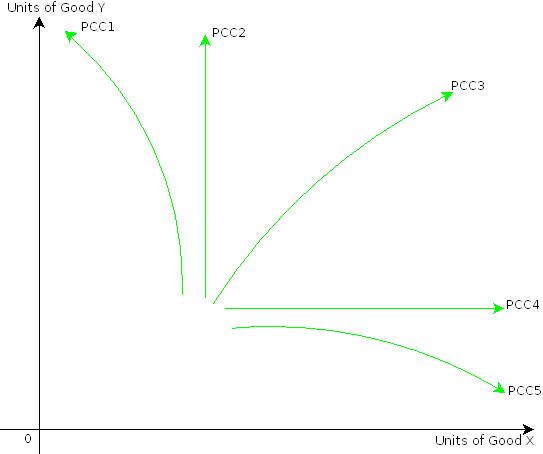
PCC1 is rising upwards and bending towards Y-axis. This form of PCC is obtained when good X is an inferior good (including Giffen goods). The PCC is a vertical straight line as shown by PCC2 when good X is a neutral good. It is a rising curve from left to right as shown by PCC3 when either good X or good Y is a normal good.The PCC is a horizontal straight line as shown by PCC4 when good Y is a neutral good. Finally, PCC5 is rising upwards bending towards X-axis. This form of PCC is obtained when good Y is an inferior good (including Giffen goods). Chart.5 presents a summary of Figure.4.
